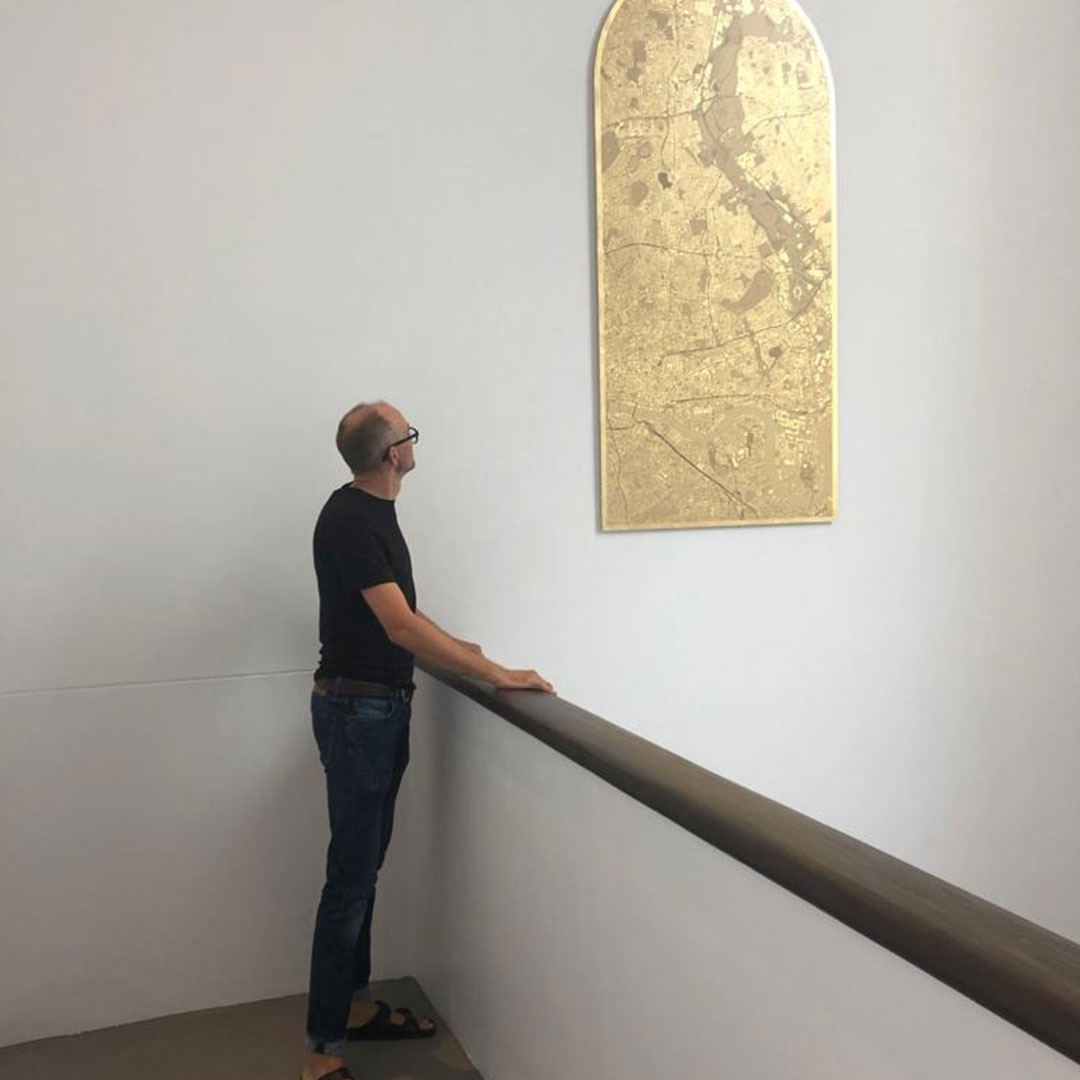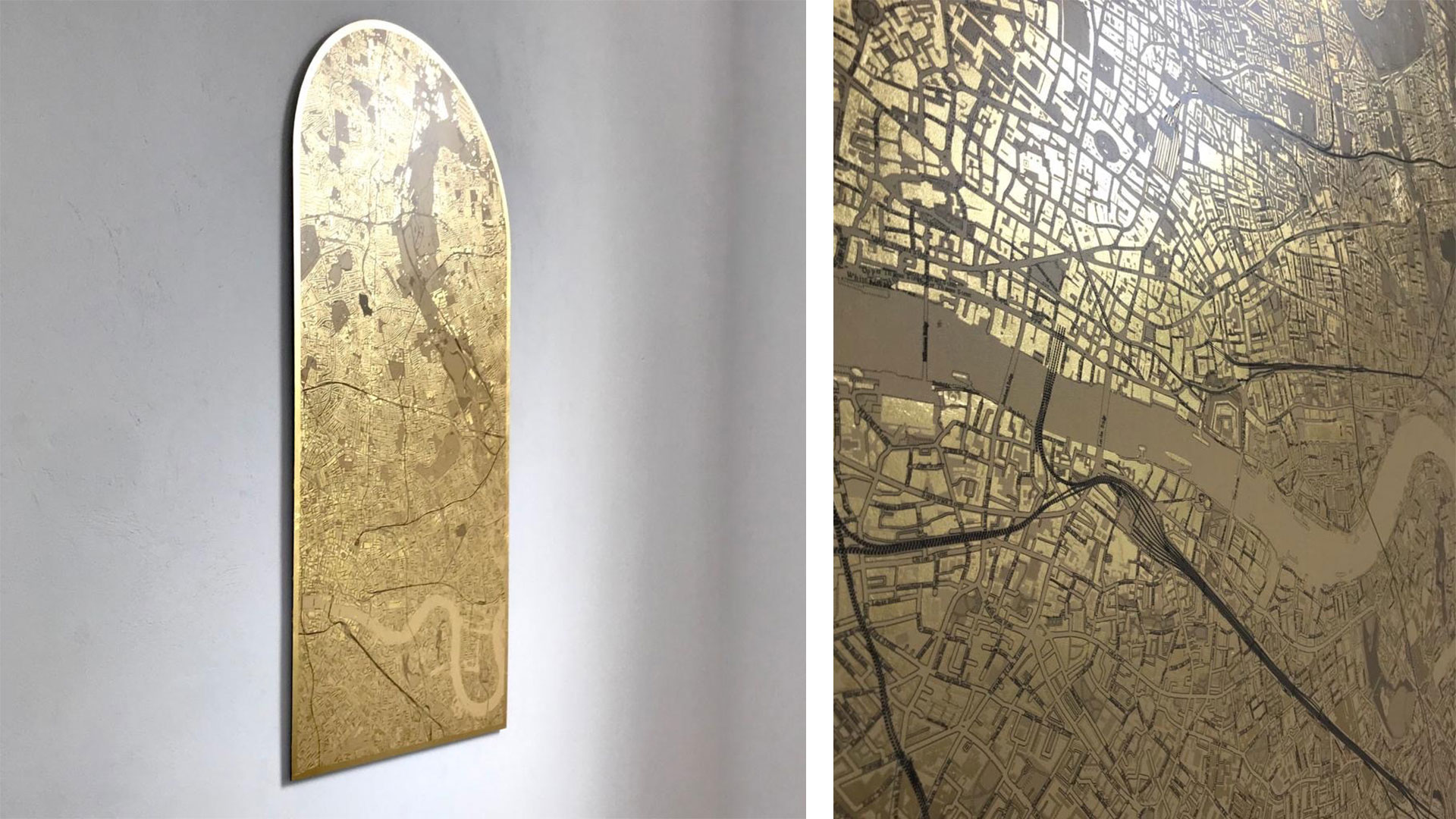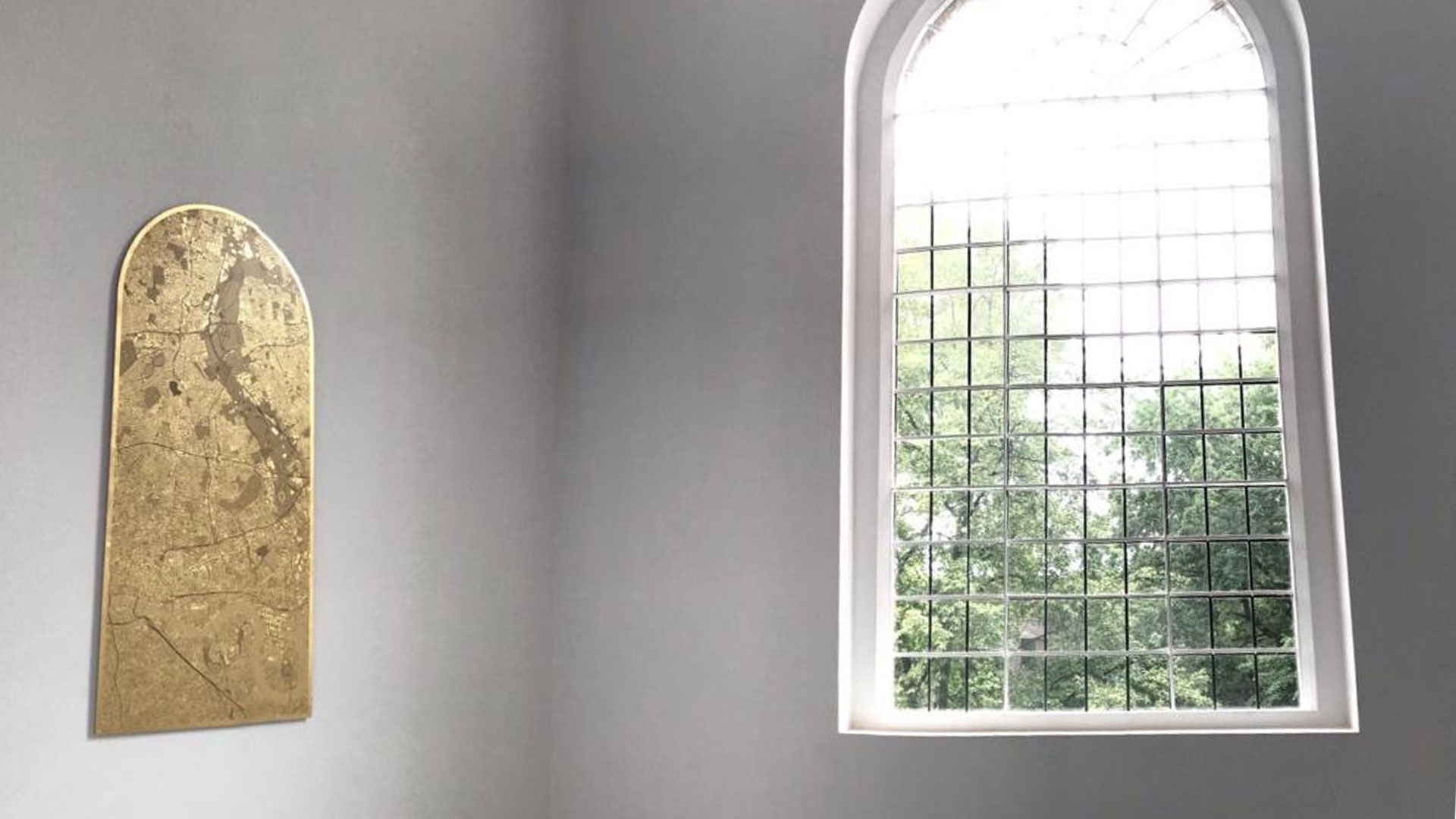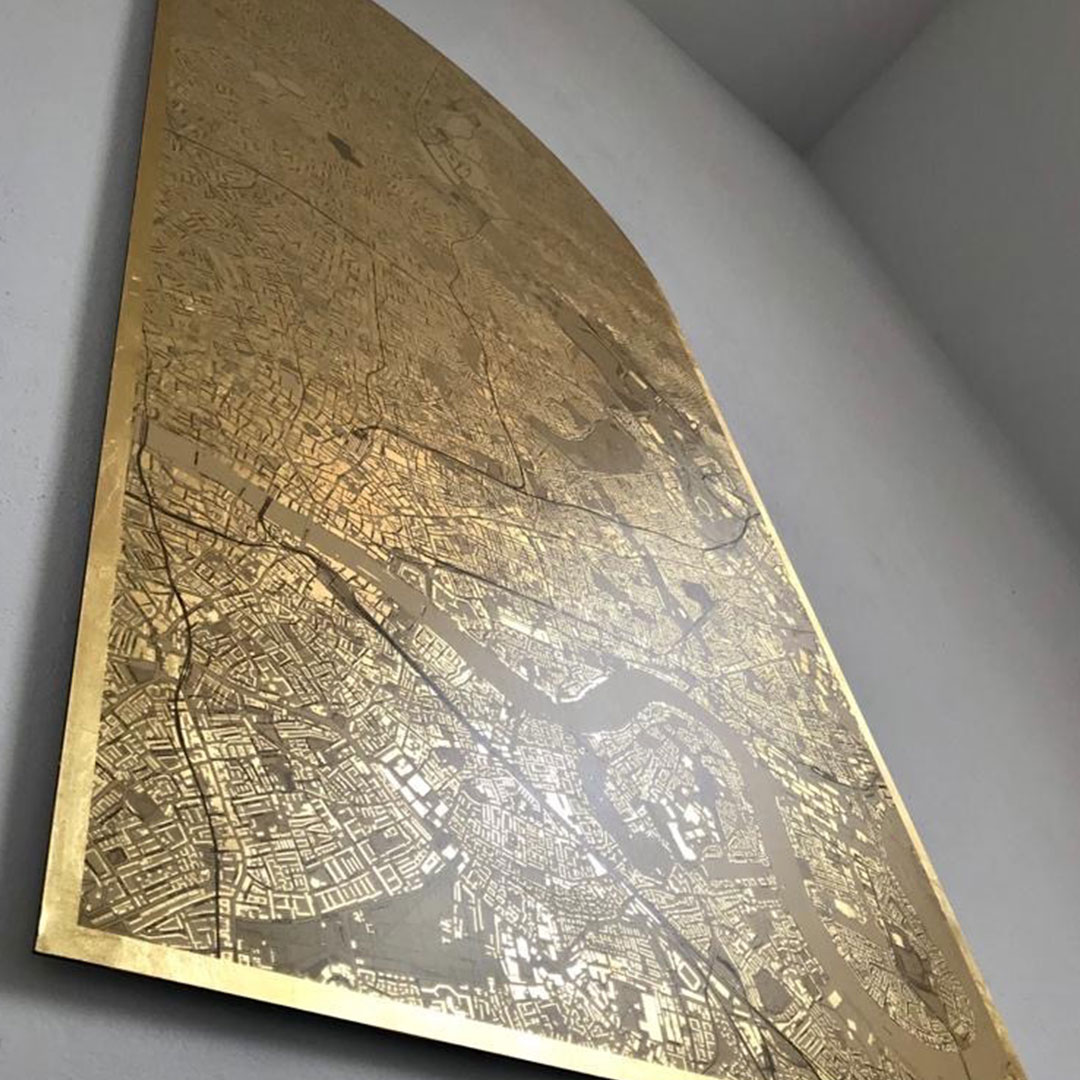A Mappa Mundi is a medieval visualisation of the known world, usually showing Jerusalem at its centre, placing the life and death of Christ at the heart of all things. Hundreds of these maps survive today, providing a unique insight into how our forbears perceived the world.
For the past two years Hackney Church has been working with East London-based gilder and mapmaker Ewan Eason to create a contemporary ‘Hackney Mappa Mundi’. Hackney Church sits at its centre, honouring the fact that for a thousand years as a local church community we have met, broken bread and worshipped God in this place.
 Ewan Eason with his Hackney Mappa Mundi.
Ewan Eason with his Hackney Mappa Mundi.PICTURED: Ewan Eason beside his ‘Hackney Mappa Mundi’ piece, located in St John at Hackney Church.
The map shows the ancient parish of Hackney and surrounding areas of East London, with the streets traced in gold – a kind of visual liturgy reflecting the fact that as a church we are rooted and called to pray, love, serve and belong in a place. The piece now hangs in the south west stairwell of St John at Hackney Church. We caught up with Ewan to talk about the piece, his work and the inspiration behind it.
Tell us a bit about your work.
Since 2010 I have been focused on the creation of abstract images from reality, drawing particular inspiration from organic and man-made patterns created in cartography. By combining this with gilding in precious metals or using complimentary colours I aim to focus the viewer on the sacredness and diversity of out living landscapes. Particularly now, it has never been more important to embrace the rich diversity of people, as well as the importance of looking after our planet.
 Ewan Eason’s Hackney Mappa Mundi on display at St John at Hackney Church
Ewan Eason’s Hackney Mappa Mundi on display at St John at Hackney ChurchDescribe your piece for Hackney Church, and how it came about.
In 2012 I began looking into various historical maps and discovered Charles Booth’s Descriptive Map of London Poverty from 1889. Booth set out to define levels of poverty and wealth in London, house by house using a colour coded system. Examples of these colours included Black defining Lowest class; Red defining Middle class and Yellow defining the Upper class. Continuing on the theme of creating abstract images from reality, I saw that the defined colours became an abstract image in themselves. By removing the colours and replacing them with one colour; Gold, I aimed to draw on the egalitarian nature of the city. I called this my Sacred City Series. Fast forward to 2014 and I was introduced to Al Gordon who had been introduced to my work through Pete Hughes, one of the lead pastor’s of Kings Cross Church (KXC). We chatted about the possibility of commissioning a piece for the yet to be renovated Hackney Church. Since then we have discussed various ideas and agreed to create a modern day Sacred City artwork of the old parish of Hackney, deciding to create the piece in an arch shape to reflect the windows and logo of the Hackney Church.
 Ewan Eason’s Hackney Mappa Mundi on display in St John at Hackney Church
Ewan Eason’s Hackney Mappa Mundi on display in St John at Hackney ChurchProximity is one of Hackney Church’s key values. Why is it important to you that this piece sits in a church?
I recently discovered that my Great Great Grandfather had lived in Hackney and was a close friend of William Booth (who had set up the Salvation Army in Hackney in 1886). So not only is it significant that I have my piece in Hackney, but I also see the significance of having my piece in a church. I think these things combining captures the values of the allegory of my work; that we are all sacred and precious no matter who or where we come from.
How do you want people to interact with the work, and what do you want it to make them think about?
Primarily, I hope to create wonder. I am a strong believer that art is a continuing conversation, either visually or verbally. My hope is that people looking at it will be inspired to have provocative conversations or to be inspired to create art themselves. Context is also key – I really hope the work draws local people in that know the area and the streets it describes. Due to the scale and distinguishing layout people will hopefully be drawn in by the detail and memories or knowledge of particular areas covered in the piece. I also like to create technically challenging pieces that prompt viewers to ask questions about how it was made.
 Ewan Eason’s Hackney Mappa Mundi on display in St John at Hackney Church
Ewan Eason’s Hackney Mappa Mundi on display in St John at Hackney ChurchGilding seems like a really intricate process. Tell us a bit about how you made the piece.
The piece is made by gilding the whole panel underneath in gold leaf, then layering the map artwork over the top leaving all the buildings transparent so the gold can be seen. The artwork is made in 6 layers. The first layer is the aluminium panel which I size up (size is a specially formulated gold leaf glue). Once this size is ready (which can take between 1-24 hours dependant on the climate) I can start to gild, overlapping each leaf slightly in order to eliminate any thin gaps in-between the leaves. Let this to dry for a minimum of 2 days. Once dry I will need to lacquer to protect the surface and stop any tarnishing (particularly important for any gold leaf which is less than 22 Carat). Once this is dry it is now ready to put the map on the top. I spent many months gathering the map info for this piece making sure every building is included. With stage complete I can now lay the map over the top of the gilded panel. All the map (apart from the buildings) has a solid white layer underneath in order to increase the differentiation and the solidity between the gold leaf and the map. Once the map is on top I can then add the subframe behind the artwork ready for it to be hung in St John at Hackney Church.
This work is shared under a Creative Commons Attribution (CC-BY-NC) Licence. Please attribute as: “Hackney Church Restoration Project (2019) by St John at Hackney Church, supported by The National Lottery Heritage Fund, licensed under CC-BY-NC”
